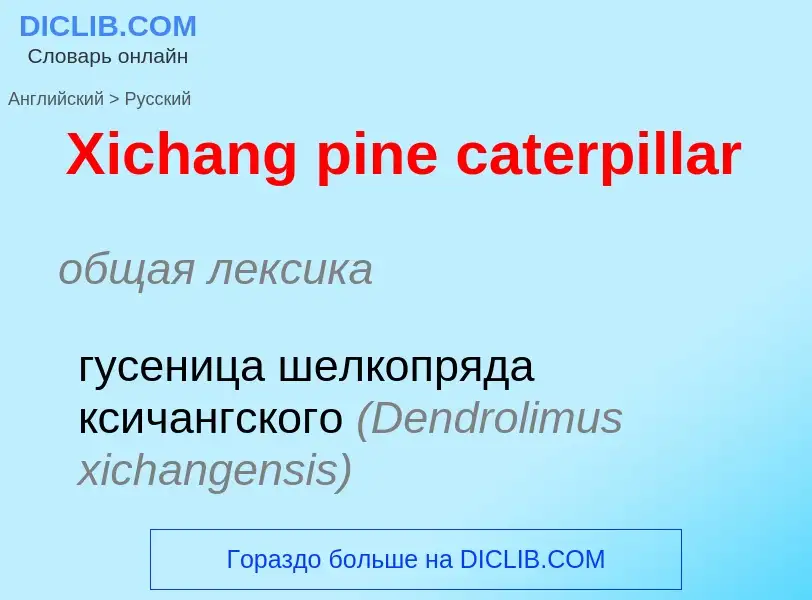Vertaling en analyse van woorden door kunstmatige intelligentie ChatGPT
Op deze pagina kunt u een gedetailleerde analyse krijgen van een woord of zin, geproduceerd met behulp van de beste kunstmatige intelligentietechnologie tot nu toe:
- hoe het woord wordt gebruikt
- gebruiksfrequentie
- het wordt vaker gebruikt in mondelinge of schriftelijke toespraken
- opties voor woordvertaling
- Gebruiksvoorbeelden (meerdere zinnen met vertaling)
- etymologie
Xichang pine caterpillar - vertaling naar russisch
общая лексика
гусеница шелкопряда ксичангского (Dendrolimus xichangensis)
общая лексика
гусеничный трактор
Definitie
Wikipedia

The pine processionary (Thaumetopoea pityocampa) is a moth of the subfamily Thaumetopoeinae in the family Notodontidae, known for the irritating hairs of its caterpillars, their processions, and the economic damage they cause in coniferous forests. The species was first described scientifically by Michael Denis and Ignaz Schiffermüller in 1775, though it was known to the ancients, with remedies described by Theophrastus, Dioscorides and Pliny the Elder. Its processionary behaviour was described in 1916 by the French entomologist Jean-Henri Fabre. It is one of the most destructive species to pines and cedars in Central Asia, North Africa and southern Europe.
The species is notable for the behaviour of its caterpillars, which overwinter in tent-like nests high in pine trees, and which proceed through the woods in nose-to-tail columns, protected from predators by their severely irritating hairs.
The species is one of the few insects where the larva develops in winter in temperate zones. Global warming is causing the species to affect forests progressively further north. The urticating hairs of the caterpillar larvae cause harmful (and in some cases allergic) reactions, in humans and other mammals.





![Tent made by larvae in pine tree; [[frass]] collects at the bottom of the tent. Tent made by larvae in pine tree; [[frass]] collects at the bottom of the tent.](https://commons.wikimedia.org/wiki/Special:FilePath/Treviño - Cerro de Treviño - Nido de procesionaria 01 (cropped).jpg?width=200)
![''[[Calosoma sycophanta]]'' beetle eating caterpillar, Turkey ''[[Calosoma sycophanta]]'' beetle eating caterpillar, Turkey](https://commons.wikimedia.org/wiki/Special:FilePath/A Calosoma sycophanta eating Thaumetopoea pityocampa.jpg?width=200)
.jpg?width=200)
![Holt 45]] gasoline crawler tractors teamed up to pull a long wagon train in the [[Mojave Desert]] during construction of the [[Los Angeles Aqueduct]] in 1909. Holt 45]] gasoline crawler tractors teamed up to pull a long wagon train in the [[Mojave Desert]] during construction of the [[Los Angeles Aqueduct]] in 1909.](https://commons.wikimedia.org/wiki/Special:FilePath/Cat45-mojave.jpg?width=200)
![A 60-horsepower Caterpillar Sixty being used for road work in the [[Cibola National Forest]], [[New Mexico]], United States in 1931 A 60-horsepower Caterpillar Sixty being used for road work in the [[Cibola National Forest]], [[New Mexico]], United States in 1931](https://commons.wikimedia.org/wiki/Special:FilePath/Caterpillar-60, 1931.jpg?width=200)
![Caterpillar-branded work boots manufactured by [[Wolverine World Wide]] Caterpillar-branded work boots manufactured by [[Wolverine World Wide]]](https://commons.wikimedia.org/wiki/Special:FilePath/Caterpillar-brand work boot.jpg?width=200)
![articulated off-road truck]] articulated off-road truck]]](https://commons.wikimedia.org/wiki/Special:FilePath/Caterpillar D350D.jpg?width=200)
![Cat 365B [[demolition]] machine in action Cat 365B [[demolition]] machine in action](https://commons.wikimedia.org/wiki/Special:FilePath/Hydraulicke demolicni nuzky na podvozku CAT 330.jpg?width=200)
![[[IDF Caterpillar D9]] armored bulldozer [[IDF Caterpillar D9]] armored bulldozer](https://commons.wikimedia.org/wiki/Special:FilePath/IDF-D9-Zachi-Evenor-001.jpg?width=200)
![A [[Caterpillar D2]], introduced in 1938, at the Serpentine Vintage Tractor Museum, [[Serpentine, Western Australia]] A [[Caterpillar D2]], introduced in 1938, at the Serpentine Vintage Tractor Museum, [[Serpentine, Western Australia]]](https://commons.wikimedia.org/wiki/Special:FilePath/Serpentine vtm cat d2 gnangarra.jpg?width=200)
![Peoria]], period 1930–1945 Peoria]], period 1930–1945](https://commons.wikimedia.org/wiki/Special:FilePath/The Caterpillar Tractor Co. Factory, Peoria, Ill.jpg?width=200)
